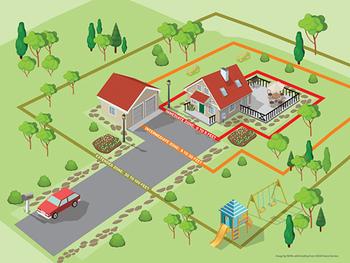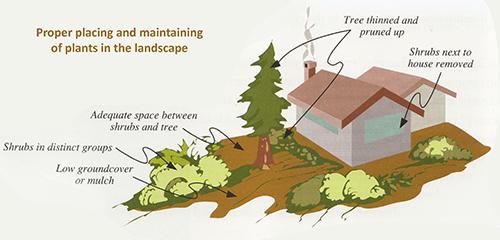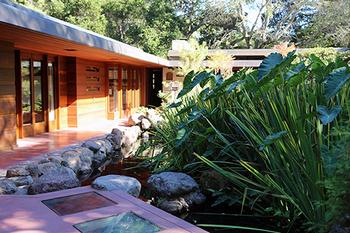Summer 2023
Climate Change: Too little water in fire prone California

Here are some ideas to help you create and maintain a drought-tolerant garden that will protect you better again wildfires and at the same time beautify your landscape and property as well.
Defensible Space
When designing a fire-resistant landscape, one of the first principles to think about is the “defensible space” around your house, which is defined as the
“…careful selection, location and maintenance of vegetation and other combustible materials on the property.”
Defensible space, also known as the Home Ignition Zone, covers 100' feet surrounding your home. Its purpose is to interrupt and slow down fire towards the home. There are 3 subzones:
- Zone 0 (0-5’) or the No Ignition Zone: This zone is the most restricted and should only contain non-combustible materials, which means no foundation plants and no vegetation overhanging the roof. It is like creating a non-flammable apron around your home, which will give you the best protection against flying embers.
- Zone 1 (5-30’) or the Lean, Green and Clean Zone containing only low growing plants and groundcovers and non-combustible materials. Flowers, edibles, succulents, even a lawn are great choices for this zone.
- Zone 2 (30-100’) or the Wildland Fuel Reduction Zone with the objective of reducing the intensity and speed of a fire by getting rid of continuous dense vegetation both horizontally and vertically. Avoid planting hedges, trim and open up tall trees, keep ground vegetation and fallen debris to a minimum. In other words: Remove, Reduce, and Replace!
We have covered defensible space in several previous articles and webinars (see References)
Hardscaping for a more drought-tolerant and fire-tolerant landscape
It is good gardening practice to look at the lay of your land first to not only create your defensible space but also to determine which areas of your garden are likely to retain a lot of water or which parts in your garden will easily dry up. Understanding your landscape's natural features, such as topography, soil type, drainage patterns, and exposure to wind and sunlight will help make good decisions. Implementing the principles of defensible space, by
- carefully selecting and placing your plants,
- and the use of non-flammable materials (hardscaping)
will help your garden survive during droughts in fire-prone California.
Ideally, you it is best to choose California native and drought-tolerant plants that are well adapted to our Mediterranean climate. These plants are more resilient to survive droughts as well as sporadic flooding. While selecting and placing your plants, follow the principles of defensible space for all 3 zones on your property and avoid planting invasive and flammable plants. \Many lists of fire-hazardous plants and fire-safe(r) plants are available but none are science-based and even at times contradict each other. Diablo Firesafe Council’s website offers a list of plants suited for our area. The Calscape website gives you the opportunity to search by zip code for California native plants that will grow well in your area.
Create plant groupings that require similar amounts of water. This keeps overall watering efficient while allowing you to deliver tailored irrigation where it is most needed. In between your planted areas spread only well composted mulch around your plants to prevent evaporation and retain moisture during dry spells. Mulch also aids in improving soil health, infiltration, water retention, and weed control. Keeping adequate space in between your plants is fire-wise practice and makes those areas more accessible during maintenance as well.
Give special attention to your shrubs and trees as they help cool our environment and reduce urban heat islands. Regular pruning, trimming, and removing dead material can significantly reduce the speed and intensity during a wildfire both horizontally and vertically. Remove lower hanging branches on tall shrubs and trees 6 feet from the ground to avoid ladder-fuels. When planting new trees always keep in mind the size at maturity and its longevity to keep proper spacing.
The use of hardscaping materials, such as gravel pathways, retaining walls, rock gardens, rocks and boulders can further reduce the risk of spreading fire. Creating pathways, dry riverbeds, patios with permeable pavers (to allow water infiltration) and non-flammable seating or even a pond are great choices in creating firebreaks while simultaneously improving the aesthetic appeal of your property.
Irrigation
Install a drip irrigation system that can be changed to meet different water requirements. Drip irrigation delivers water directly to the root zone minimizing water waste through evaporation. Use moisture meters or weather-based sensors to track soil moisture levels and adjust irrigation as necessary. Collect and reuse water where possible. By performing these more sustainable practices, you can avoid overwatering, runoff and erosion during wet weather and save water during dry intervals.
Adequate drainage is not only important with too much water (refer to Robin’s article), but it can also aid with water retention during dry seasons. Swales, dry creek beds, and rain gardens are a few examples of water collection and redirection techniques.
Soil Health
Pay attention to your soil and amend where needed with organic matter such as compost. Healthy well-draining soil prevents water runoff and promotes deep root growth. Plants that struggle growing in your soil often produce a lot of dead material and will eventually die off.
And lastly, stay informed and connected with your neighbors, community, and your local fire department for guidelines and restrictions on certain plants and landscape practices.
“We are the first generation to feel the impact of climate change and the last generation that can do something about it. “
— Washington Governor Jay Inslee
Links and References:
Defensible Space
Firesmart Landscaping, short 6 min. video by UC Master Gardeners of Marin County
Previous firescaping articles published in News to Grow By:
Living with Wildfire (2022 Fall issue)
About Firescaping Plant Lists (2022 Summer issue)
Wildfire Preparedness (2022 Summer issue)
Container Gardening: Water Saving Techniques (2022 Fall issue)
Add a Flow Meter to Monitor your Water Usage (2022 Summer issue)
Hardening your Home and Landscape webinar and Climate Change webinar by Lori Palmquist
Preparing Home Landscaping for Fire
Drought Gardening Tips
Low-Water Plant List and Photos provided by Contra Costa Water District
The combustibility of Landscape Mulches by the University of Nevada
